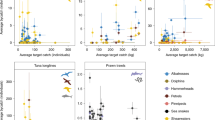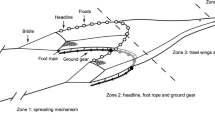Abstract
This paper attempts to provide a synthesis of several issues relevant to the study and management of bycatches. It includes a proposed set of definitions for the different fractions of the harvest (catch, bycatch, release) and for other impacts of the fishing process, either at sea or in port. It also provides a system for the classification of bycatches that shows some basic similarities and differences among fisheries.
The classifications are based on different criteria, including the degree of spatial or temporal ‘aggregation’ of bycatches, the degree of control that the fishers have, the frequency of occurrence, its predictability, its ecological or random origin, the level of impact of bycatches, and whether bycatches are the result of market conditions or regulations.
One of the main issues to address in plans to deal with bycatches is defining the objectives to be pursued. These objectives can include ecological or socio-economic goals, and some of the possible goals are briefly discussed. Once the targets are set, it is necessary to find the strategies to achieve them. The bycatch process is quite simple because it has only two controls: the average impact per unit of effort and the total level of effort. The definition of effort used is not always equivalent to the one used in fisheries models.
If a decision is made to reduce the ecological impacts of a fishery, three sets of tools are available to achieve it, acting over the two controls mentioned above: technology, training of fishers, and management measures. Five possible lines of defence are available to reduce bycatches: (1) increasing the selectivity of the fishery by choices of gear, areas, or seasons; (2) modifying deployment conditions; (3) increasing the fraction released alive either from the gear, or (4) later, from the deck; or (5) increasing the utilization to make catches out of the incidental captures.
One of the options more commonly used to manage fisheries problems is the development of incentive/disincentive programmes, with both positive and negative responses applied to the fishers in accordance to their level of performance. Some examples are mentioned.
Some of the challenges facing scientists, managers, the fishing industry and the environmental community to tackle the bycatch problems in coming years are also presented.
Similar content being viewed by others
References
Alverson, D.L., Freeberg, M.H., Pope, J.G. and Murawski, S.A. (1994) A global assessment of fisheries bycatch and discards. Rome: FAO, FAO Fish. tech. Pap. No. 339. 233 pp.
Andrew, N.L. and Pepperell, J.G. (1992) The by-catch of shrimp trawl fisheries. Oceanogr. mar. Biol. ann. Rev. 30, 527–565.
Andrew, N.L., Kennelly, S.J. and Broadhurst, M.K. (1993) An application of the Morrison soft TED to the offshore prawn fishery in New South Wales, Australia. Fish. Res. 16, 101–111.
Anonymous. (1995) Report of the Study Group on Ecosystem Effects of Fishing Activities. I.C.E.S. Coop. Res. Rept. No. 200. 120 pp. September 1995.
Au, D. (1991) Polyspecific nature of tuna schools: shark, dolphin, and seabird associates. Fish. Bull., U.S. 89, 343–354.
Barlow, J., Swartz, S.L., Eagle, T.C. and Wade, P.R. (1995) U.S. Marine mammal stock assessments: guidelines for preparation, background, and a summary of the 1995 assessments. NOAA tech. Memo. NMFS-OPR-6, September 1995.
Beltestad, A.K. and Misund, O.A. (1993) Sorting of mackerel by grids in purse seines and trawls. Fisken-Havet, No. 8, 21 pp. (in Norwegian with English summary).
Ben-Yami, M. (1994) Purse Seining Manual. Oxford: Fishing News Books. 406 pp.
Broadhurst, M.K. and Kennelly, S.J. (1994) Reducing the by-catch of juvenile fish (mulloway Argyrosomus hololepidotus) using square-mesh panels in codends in the Hawkesbury River prawn-trawl fishery, Australia. Fish. Res. 19, 321–331.
Coe, J.M. and Sousa, G. (1972) Removing porpoises from a tuna purse seine. Mar. Fish. Rev. 34(11–12), 15–19.
Coe, J.M., Holts, D.B. and Butler, R.W. (1984) The ‘tuna-porpoise’ problem: NMFS dolphin mortality reduction research, 1970–81. Mar. Fish. Rev. 46, 18–33.
Crowley, M. (1994) What's new in TEDs? National Fisherman (August 1994), 34–36.
Francis, R.C., Awbrey, FT., Goudey, C.L., Hall, M.A., King, D.M., Medina, H., Norris, K.S., Orbach, M.K., Payne, R. and Pikitch, E. (1992) Dolphins and the Tuna Industry. Washington, DC: National Research Council, National Academy Press. 176 pp.
Guillory, V. and Hutton, G. (1982) A survey of bycatch in the Louisiana Gulf Menhaden fishery. Proc. 36th Ann. Conf. Southeast. Assoc. Fish-Wildl. Agencies (SEAFWA). Jacksonville, Florida, Oct. 31–Nov. 3, 1982. pp. 213–223.
Hall, M.A. and Boyer, S.D. (1988) Incidental mortality of dolphins in the eastern tropical Pacific tuna fishery in 1986. Rep. int. Whal. Commn 38, 439–441.
Hall, M.A. (1995a) A classification of bycatch problems and some approaches to their solutions. Report of the Workshop held at the Fisheries Centre, Univ. of British Columbia, November 1994. Vancouver: Fisheries Centre.
Hall, M.A. (1995b) Strategies to reduce the incidental mortality of marine mammals and other species in fisheries. (Dev. Mar. Biol., Vol. IV) (eds A.S. Blix, L. Walløe and ø. Ulltang) Amsterdam: Elsevier. pp. 537–544.
Hall, M.A. and Boyer, S.D. (1986) Incidental mortality of dolphins in the eastern tropical Pacific tuna fishery: description of a new method and estimation of 1984 mortality. Rep. int. Whal. Commn 36, 375–381.
Jefferson, T.A. and Curry, B.E. (1994) A global review of porpoise (Cetacea: Phocoenidae) mortality in gillnets. Biol. Conserv. 67, 167–183.
Joseph, J. (1994) The tuna-dolphin controversy in the eastern Pacific Ocean: biological, economic and political impacts. Ocean Dev. int. Law 25, 1–30.
Kim, J.O. and Choo, H.D. (1993) A study on the fish behavior control by air-bubble curtains. Bull. Nat. Fish. Res. Dev. Agency 47, 241–249. (in Korean with English summary).
Klinowska, M. (1991) Dolphin, Porpoises and Whales of the World. The IUCN Red Data Book. Gland, Switzerland and Cambridge, UK: IUCN. 429 pp.
Lennert, C. and Hall, M.A. (1995) Estimates of incidental mortality of dolphins in the eastern Pacific Ocean tuna fishery in 1993. Rep. int. Whal. Commn 45, 387–390.
Lennert, C. and Hall, M.A. (1996) Estimates of incidental mortality of dolphins in the eastern Pacific Ocean tuna fishery in 1994. Paper SC/47/SM1 presented to the IWC Scientific Committee, June 1995. (in press).
Lien, J. (1994) Entrapments of larger cetaceans in passive inshore fishing gear in Newfoundland and Labrador (1979–1990). In Perrin, W.F., Donovan, G. and Barlow, J. eds, Gillnets and Cetaceans (Int. Whal. Commn Special Issue No. 15). Cambridge: IWC. pp. 149–157.
Lien, J., Hood, C., Pittman, D., Ruel, P., Borggaard, D., Chisholm, C., Wiesner, L., Mahon, T. and Mitchell, D. (1995) Field tests of acoustic devices on groundfish gillnets: assessment of effectiveness in reducing harbour porpoise by-catch. In Kastelein, R., Thomas, J.A. and Nachtigal, P.E. eds. Sensory Systems of Aquatic Mammals Woerden, The Netherlands: De Spil Publishers. pp. 349–364.
Lo, N.C.H. and Smith, T.D. (1986) Incidental mortality of dolphins in the eastern tropical Pacific, 1959–1972. Fish. Bull. U.S. 84, 27–34.
Lockwood, S.J., Pawson, M.G. and Eaton, D.R. (1983) The effects of crowding on mackerel (Scomber scombrus L.) — physical condition and mortality. Fish. Res. 2, 129–147.
McCaughran, D.A. (1992) Standardized nomenclature and methods of defining by catch levels and implications. In Schoning, R.W., Jacobson, R.W., Alverson, D.L., Gentle, T.H. and Auyong, J., eds. Proceedings of the National Industry Bycatch Workshop. Newport, Oregon, February 4–6, 1992. Seattle, WA: Natural Resources Consultants, pp. 200–201.
Merino, J.M. (1991) La Pesca Desde la Prehistoria Hasta Nuestros Días, 2a. edición. Servicio Central de Publicaciones del Gobierno Vasco. Depto. de Agriculture y Pesca, Administración de la Comunidad Autônoma del Pais Vasco. 494 pp.
Misund, O.A. and Skeide, R. (1992) Grid-sorting of penned saithe. ICES C.M. 1992/B:11, 5 pp.
Northridge, S.P. (1984) World review of interactions between marine mammals and fisheries. Rome: FAO, FAO Fish. tech. Pap. No. 251. 190 pp.
Northridge, S.P. (1991) An updated world review of interactions between marine mammals and fisheries. Rome: FAO, FAO Fish. tech. Pap. No. 251, Suppl. 1. 58 pp.
Pawson, M.G. and Lockwood, S.J. (1980) Mortality of mackerel following physical stress, and its probable cause. Rapp. P.-v. Réun. Cons. int. Explor. Mer 177, 439–443.
Perrin, W.F., Donovan, G.P. and Barlow, J. (eds) (1994a). Gillnets and Cetaceans (Rep. int. Whal. Commn, Spec. Issue 15). Cambridge: IWC. 629 pp.
Perrin, W.F., Donovan, G.P. and Barlow, J. (eds) (1994b). Report of the workshop on mortality of cetaceans in passive fishing nets and traps. In Perrin, W.F., Donovan, G.P. and Barlow, J. (eds) Gillnets and Cetaceans (Rep. int. Whal. Commn, Spec. Issue 15). Cambridge: IWC. pp. 1–71.
Punsly, R. (1987) Estimation of relative annual abundance of yellowfin tuna, Thunnus albacares, in the eastern Pacific Ocean during 1970–1985. Inter-Amer. Trop. Tuna Comm. Bull., 19(3), 261–306.
Punsly, R.G., Tomlinson, P.K. and Mullen, A.J. (1994) Potential tuna catches in the eastern Pacific Ocean from schools not associated with dolphins. Fish. Bull. U.S. 92, 132–143.
Smith, K.A. (1964) The use of air-bubble curtains as an aid to fishing. In Modern Fishing Gear of the World, Vol. 2. pp. 540–544. London: Fishing News (Books).
Van Waebereek, K. and Reyes, J.C. (1994) Post-ban small cetacean takes off Peru: a review. In Perrin, W.F., Donovan, G.P. and Barlow, J. (eds) Gillnets and Cetaceans (Rep. int. Whal. Commn, Spec. Issue 15). Cambridge: IWC. pp. 503–519.
Vidal, O. (1993) Aquatic mammal conservation in Latin America: Problems and Perspectives. Conserv. Biol. 7, 788–795.
Wade, P.R. and Gerrodette, T. (1993) Estimates of cetacean abundance and distribution in the eastern tropical Pacific. Rep. int. Whal. Commn. 43, 477–493.
Young, N.M., Iudicello, S., Evans, K. and Baur, D. (1993) The Incidental Capture of Marine Mammals in U.S. Fisheries: Problems and Solutions. Washington D.C.: Center for Marine Conservation, 415 pp.
Author information
Authors and Affiliations
Rights and permissions
About this article
Cite this article
Hall, M.A. On bycatches. Rev Fish Biol Fisheries 6, 319–352 (1996). https://doi.org/10.1007/BF00122585
Accepted:
Issue Date:
DOI: https://doi.org/10.1007/BF00122585




